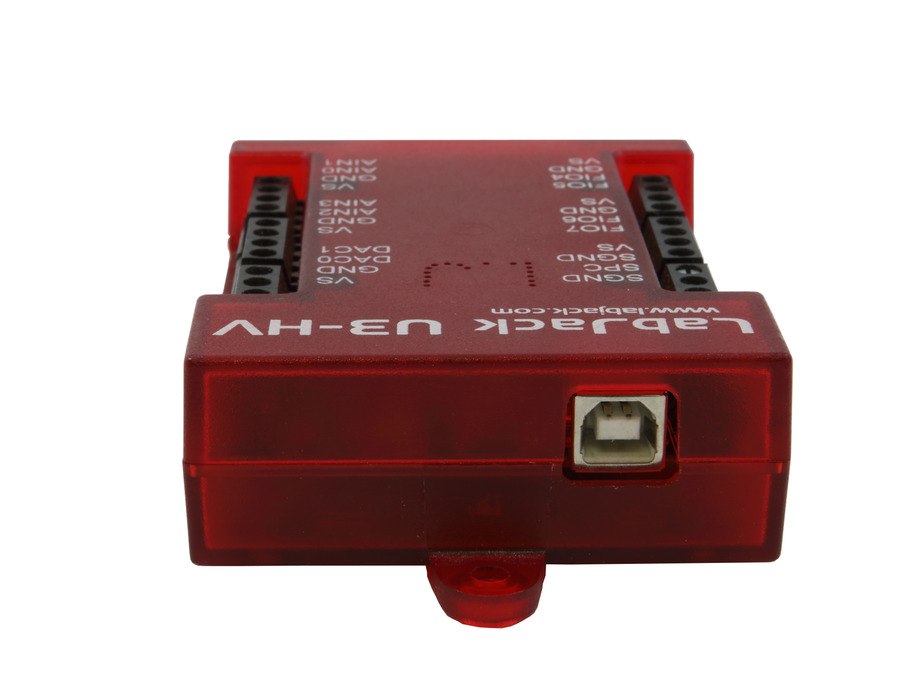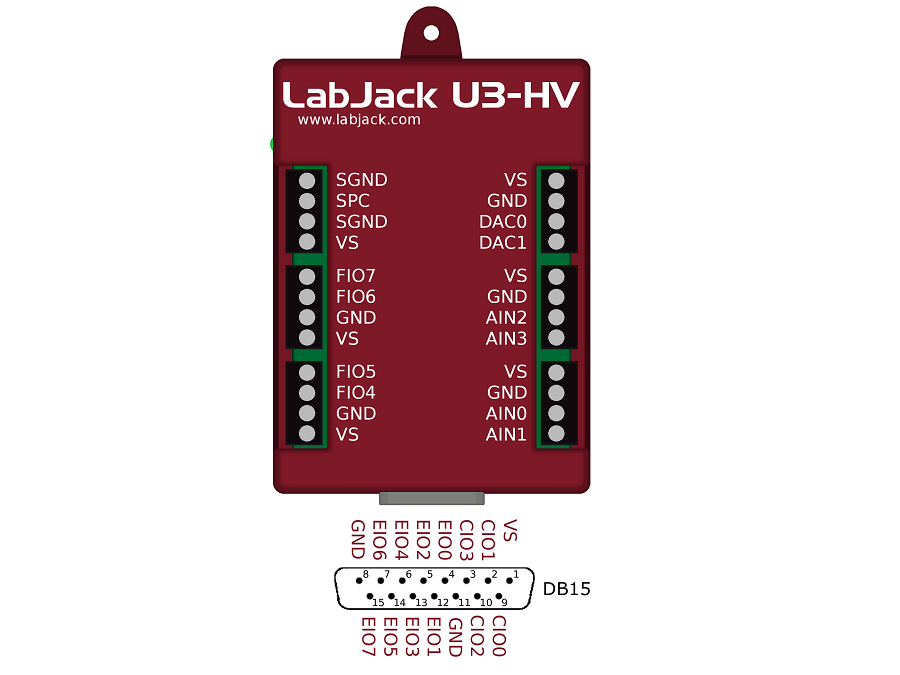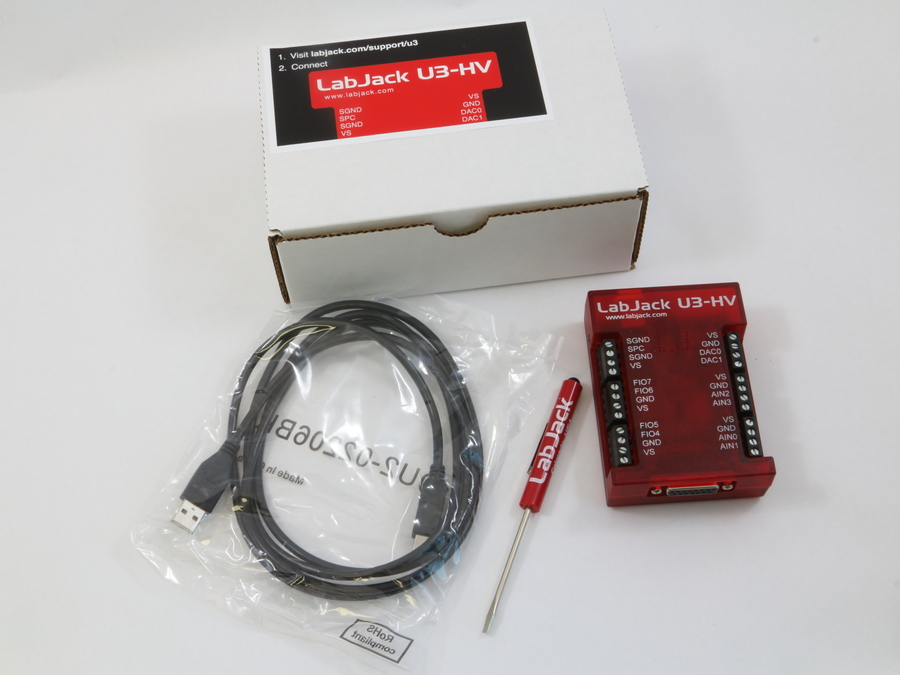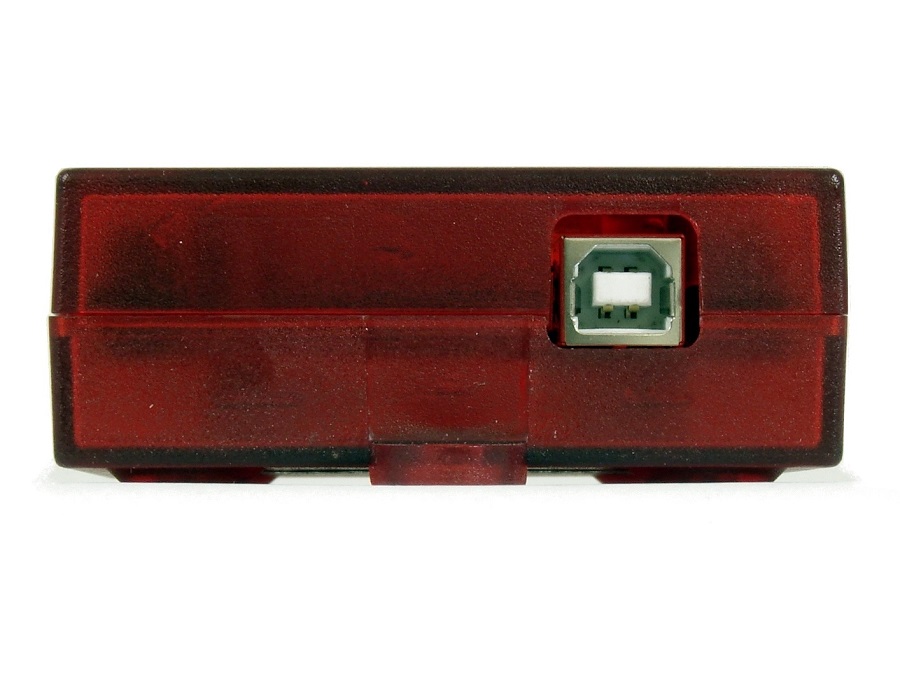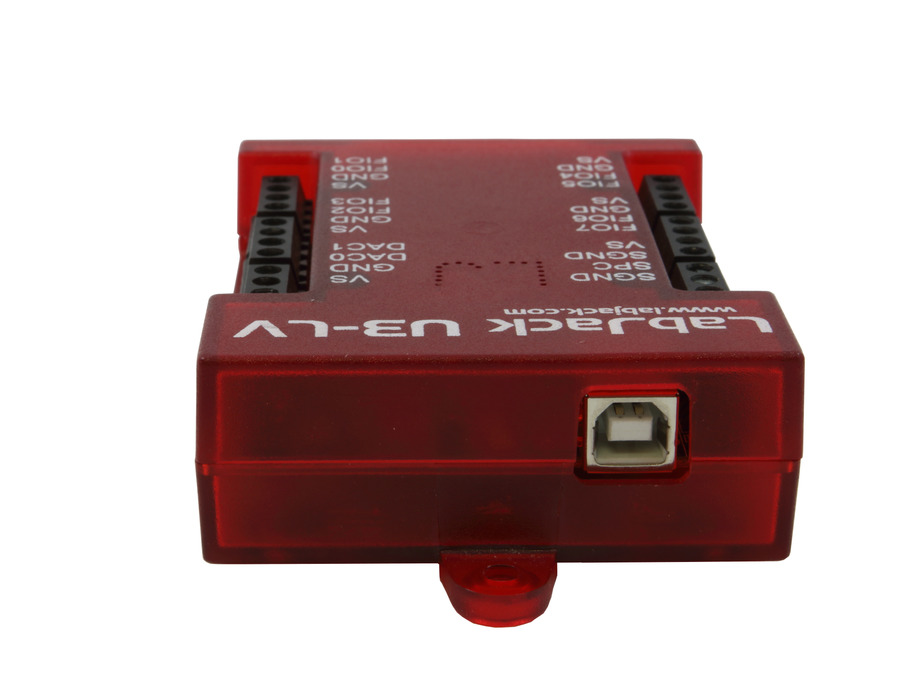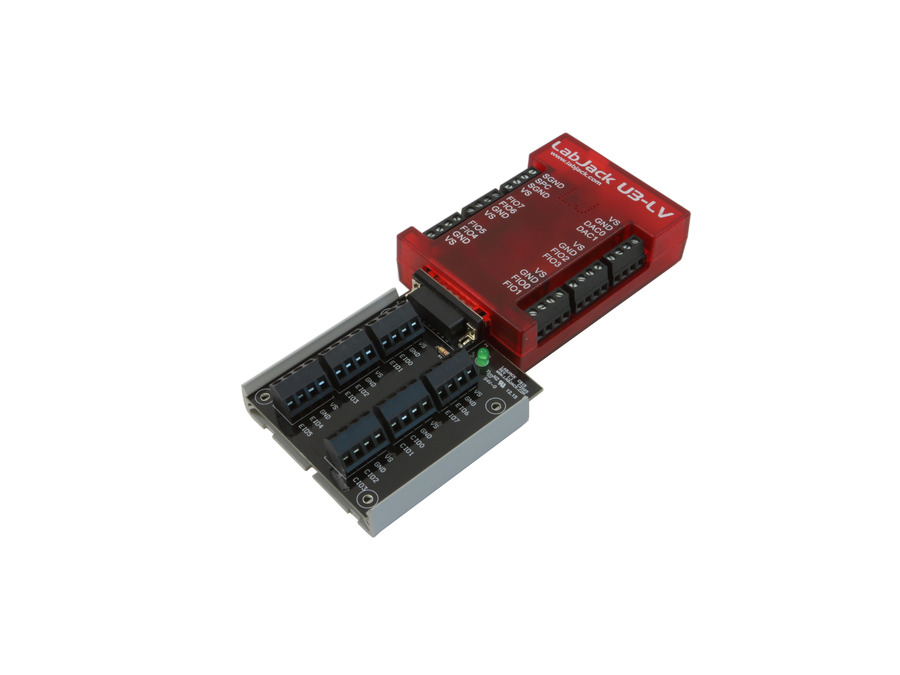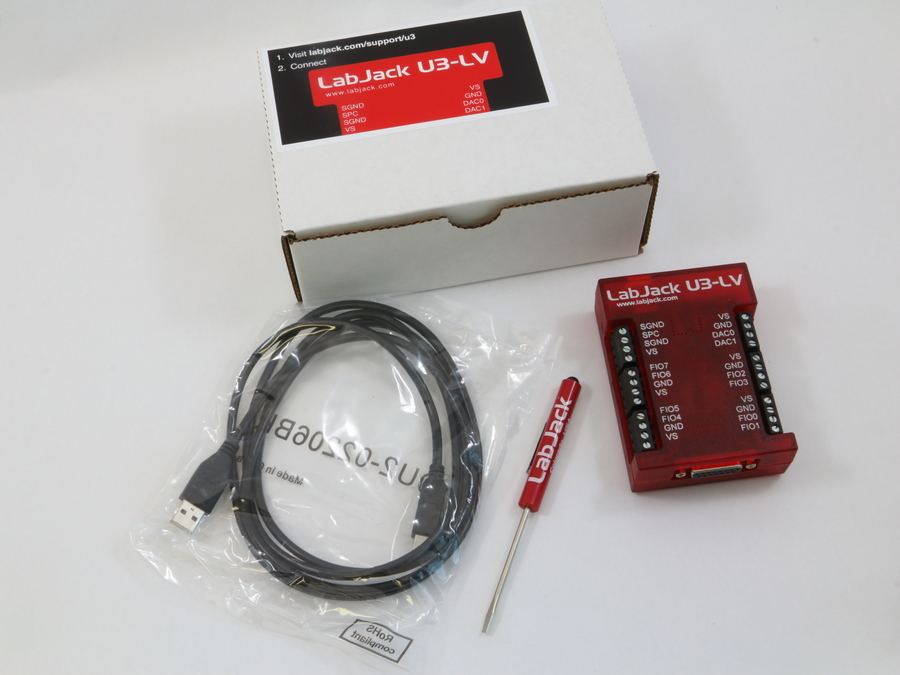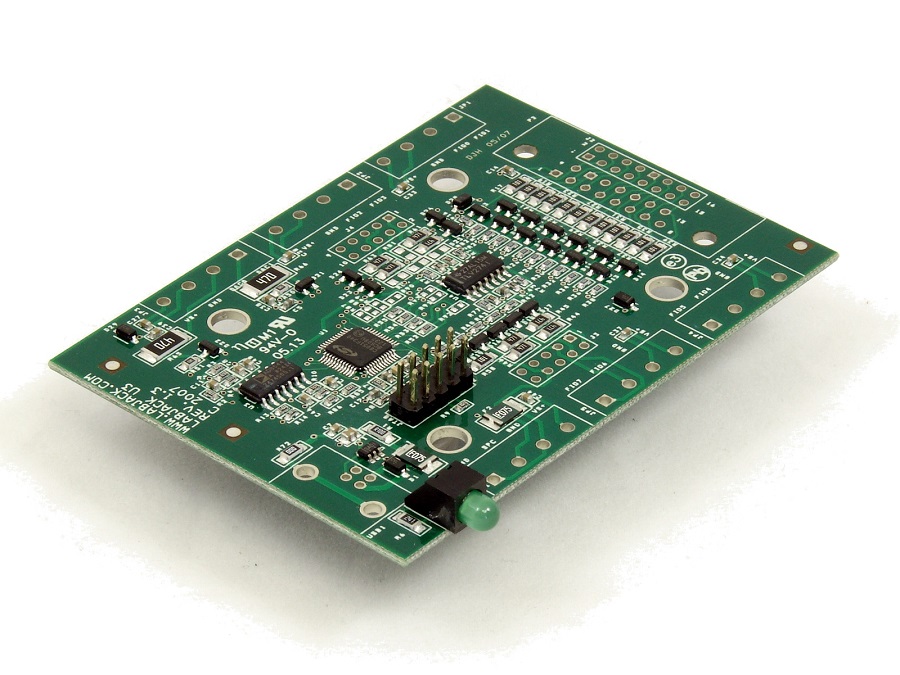USB DAQ device with 4 dedicated high-voltage analog inputs, 12 flexible I/O, and 4 dedicated digital I/O. The flexible I/O can be configured as either digital or analog, thus providing up to 16 analog inputs, or up to 16 digital I/O. It also has two 10-bit analog outputs, up to 2 counters, and up to 2 timers.
USB Multifunction DAQ
The U3 family devices are versatile for measurement and control within simple analog and digital systems. With the option to configure I/O as either analog or digital, you have flexibility when choosing sensors for your application. Common applications include hobbyist projects, educational programs, industrial control and monitoring, and prototype development.
USB DAQ device with 16 flexible I/O, and 4 dedicated digital I/O. The flexible I/O can be configured as either digital or analog, thus providing up to 16 analog inputs, or up to 20 digital I/O. It also has two 10-bit analog outputs, up to 2 counters, and up to 2 timers.
USB Multifunction DAQ
The U3 family devices are versatile for measurement and control within simple analog and digital systems. With the option to configure I/O as either analog or digital, you have flexibility when choosing sensors for your application. Common applications include hobbyist projects, educational programs, industrial control and monitoring, and prototype development.
The -OEM variant does not include the screw terminals or enclosure. Designed for direct integration into a larger product, or platform.
USB Multifunction DAQ
The U3 family devices are versatile for measurement and control within simple analog and digital systems. With the option to configure I/O as either analog or digital, you have flexibility when choosing sensors for your application. Common applications include hobbyist projects, educational programs, industrial control and monitoring, and prototype development.
The -OEM variant does not include the screw terminals or enclosure. Designed for direct integration into a larger product or platform.
USB Multifunction DAQ
The U3 family devices are versatile for measurement and control within simple analog and digital systems. With the option to configure I/O as either analog or digital, you have flexibility when choosing sensors for your application. Common applications include hobbyist projects, educational programs, industrial control and monitoring, and prototype development.
Flexible I/O:
The first 16 I/O lines (FIO and EIO ports) on the LabJack U3-LV can be individually configured as digital input, digital output, or analog input. In addition, up to 2 of these lines can be configured as timers, and up to 2 of these lines can be configured as counters. On the U3-HV, the first 4 flexible I/O are replaced with dedicated high-voltage analog inputs.
The first 8 flexible I/O lines (FIO0-FIO7) appear on built-in screw terminals. The other 8 flexible I/O lines (EIO0-EIO7) are available on the DB15 connector.
For more information, see Section 2.5 – Flexible I/O (FIO/EIO) of the U3 Datasheet.
Analog Inputs:
The LabJack U3 has up to 16 analog inputs available on the flexible I/O lines. Single-ended measurements can be taken of any line compared to ground, or differential measurements can be taken of any line to any other line.
Analog input resolution is 12-bits. The range of single-ended low-voltage analog inputs on the U3-LV is typically 0-2.4 volts or 0-3.6 volts, and the range of differential analog inputs is typically ±2.4 volts (pseudobipolar only). For valid measurements, the voltage on every analog input pin, with respect to ground, must be within -0.3 to +3.6 volts.
On the U3-HV, the first 4 flexible I/O are replaced with dedicated high-voltage analog inputs. The input range of these channels is ±10 volts or -10/+20 volts. The remaining 12 flexible I/O are still available as described above, so the U3-HV has 4 high-voltage analog inputs and up to 12 low-voltage analog inputs.
Command/response (software timed) analog input reads typically take 0.6-4.0 ms depending on number of channels and communication configuration. Hardware timed input streaming has a maximum rate that varies with resolution from 2.5 ksamples/s at 12-bits to 50 ksamples/s at about 10-bits.
For more information see the U3 Datasheet. For analog input information see Section 2.6 – AIN and Appendix A. For data rate information see Sections 3.1 – Command/Response and Sections 3.2 – Stream Mode.
Analog Outputs:
The LabJack U3 has 2 analog outputs (DAC0 and DAC1) that are available on the screw terminals. Each analog output can be set to a voltage between 0 and 5 volts with 10-bits of resolution.
The analog outputs are updated in command/response mode, with a typical update time of 0.6-4.0 ms depending on communication configuration. The analog outputs have filters with a 3 dB cutoff around 16 Hz, limiting the frequency of output waveforms to less than that.
For more information see the U3 Datasheet. For analog output information see Section 2.7 – DAC and Appendix A. For data rate information see Section 3.1 – Command/Response.
Digital I/O:
The LabJack U3 has up to 20 digital I/O channels. 16 are available from the flexible I/O lines, and 4 dedicated digital I/O (CIO0-CIO3) are available on the DB15 connector. Each digital line can be individually configured as input, output-high, or output-low. The digital I/O use 3.3 volt logic and are 5 volt tolerant.
Command/response (software timed) reads/writes typically take 0.6-4.0 ms depending on communication configuration. The first 16 digital inputs can also be read in a hardware timed input stream where all 16 inputs count as a single stream channel.
For more information see the U3 Datasheet. For digital I/O information see Section 2.8 – Digital I/O and Appendix A. For data rate information see Section 3.1 – Command/Response and Sections 3.2 – Stream Mode.
Timers:
Up to 2 flexible I/O lines can be configured as timers. The timers are very flexible, providing options such as PWM output, pulse/period timing, pulse counting, and quadrature input.
For more information see the U3 Datasheet. For timers information see Section 2.9 – Timers/Counters and Appendix A.
Counters:
Up to 2 flexible I/O lines can be configured as 32-bit counters.
For more information see the U3 Datasheet. For counters information see Section 2.9 – Timers/Counters and Appendix A.
I/O Protection:
All I/O lines on the U3 are protected against minor overvoltages. The FIO lines can withstand continuous voltages of up to ±10 volts, while the EIO/CIO lines withstand continuous voltages of up to ±6 volts.
High Channel Count Applications:
By using USB hubs, many LabJacks can be interfaced to a single PC, providing an inexpensive solution for high channel count applications.
LV (Low-Voltage) Version:
- 16 Flexible I/O (Digital Input, Digital Output, or Analog Input)
- Up to 2 Timers (Pulse Timing, PWM Output, Quadrature Input, …)
- Up to 2 Counters (32-Bits Each)
- 4 Additional Digital I/O
- Up to 16 12-bit Analog Inputs (0-2.4 V or 0-3.6 V, SE or Diff.)
- 2 Analog Outputs (10-Bit, 0-5 volts)
- Supports SPI, I2C, and Asynchronous Serial Protocols (Master Only)
- Supports Software or Hardware Timed Acquisition
- Maximum Input Stream Rate of 2.5-50 kHz (Depending on Resolution)
- Capable of Command/Response Times Less Than 1 Millisecond
- Built-In Screw Terminals for Some Signals
- OEM Version Available
- USB 2.0/1.1 Full Speed Interface
- Powered by USB Cable
- Drivers Available for Windows, Linux, Mac and Pocket PC
- Examples Available for C/C++, VB, LabVIEW, Java, and More
- Includes USB Cable and Screwdriver
- Free Firmware Upgrades
- Money Back Guarantee
- Enclosure Size Approximately 3″ x 4.5″ x 1.2″ (75mm x 115mm x 30mm)
- Rated for Industrial Temperature Range (-40 to +85 Degrees C)
HV (High-Voltage) Version:
Same features as the LV version except:
- First 4 Flexible I/O are Changed to Dedicated HV Analog Inputs.
- 4 HV Inputs have ±10 Volt or -10/+20 Volt Range.
- 12 LV Inputs (Flexible I/O) Still Available, for 16 Total Analog Inputs.
For more technical specifications look at the U3’s datasheet.
U3-HV vs U3-LV
| U3-LV | U3-HV | |
| # Low-voltage AINs: | 16 | 12 |
| # High-voltage AINs: | 0 | 4 |
| # DIOs: | 20 | 16 |
The U3-HV has the following differences versus the U3-LV:
- First 4 flexible I/O are changed to dedicated HV analog inputs.
- 4 HV inputs have ±10 volt or -10/+20 volt range.
- 12 LV inputs (flexible I/O) still available, for 16 total analog inputs.
OEM Versions
The U3-LV-OEM or U3-HV-OEM includes the board only without the enclosure and without most through-hole components. See Section 2.12 of the U3 Datasheet for more information.
Optional Accessories:
The CB15 is a simple screw terminal breakout for the DB15 connector.
The RB12 provides a convenient interface for the U3 to industry standard digital I/O modules, allowing electricians, engineers, and other qualified individuals, to interface a LabJack with high voltages/currents. The RB12 relay board connects to the DB15 connector on the LabJack, using the 12 EIO/CIO lines to control up to 12 I/O modules. Output or input types of digital I/O modules can be used. The RB12 is designed to accept G4 series digital I/O modules from Opto22, and compatible modules from other manufacturers such as the G5 series from Grayhill. Output modules are available with voltage ratings up to 200 VDC or 280 VAC, and current ratings up to 3.5 amps.
The LJTick-Divider (LJTD) signal-conditioning module is designed to divide 2 single-ended higher voltage analog signals down to 0-2.5 volt signals.
The LJTick-DAC (LJTDAC) provides a pair of 14-bit analog outputs with a range of ±10 volts. Plugs into any digital I/O block, and thus up to 10 of these can be used per device to add 20 analog outputs.
The LJTick-InAmp (LJTIA) signal-conditioning module provides two instrumentation amplifiers ideal for low-level signals such as bridge circuits (e.g. strain gauges) and thermocouples. Each amplifier converts a differential input to single-ended.
The LJTick-RelayDriver (LJTRD) allows 2 digital I/O lines to each control a relay or other moderate load up to 50V/200mA.
The LJTick-CurrentShunt (LJTCS) signal-conditioning module is designed to convert a 4-20 mA current loop input signal into a 0.47-2.36 volt signal.
The LJTick-Proto (LJTP) consists of an 8×8 grid of holes for prototyping custom signal-conditioning modules.
Satisfaction Guaranteed:
Everything we sell has a 30-day money back guarantee. If, for any reason, you are not satisfied with a product, contact us to arrange your choice of a refund or replacement. In addition, the LabJack U3 is covered by a 1-year limited warranty.
Technical Support:
All LabJacks include lifetime technical support. Support resources include forum, FAQs, email, and telephone.
Drivers and Examples:
LabJack provides drivers for the three major operating systems and examples for most common programming languages. For more information see the U3 software options page.
Firmware:
Be sure to keep an eye on the U3 Firmware page for the latest U3 firmware.
Package Contents (Non-OEM)
- U3 (-HV/-LV) unit itself in red enclosure
- USB cable (6 ft / 1.8 m)
- Screwdriver
- Other package details: No software CD included. Download the software from labjack.com.
- Retail packing (Package) size: 7″ x 4.5″ x 3″
- Retail packing (Package) wt: 0.8lb
CB15 Terminal Board
Provides convenient screw terminals for the 12 digital I/O lines on the DB15 connector of compatible LabJack devices.
RB12 Relay Board
Provides 12 industry standard relay module sockets to a U3.
LJTick-Divider
The LJTick-Divider (LJTD) is a signal conditioning module designed to take two single-ended higher voltage analog signals, and divide them by a specified value.
LJTick-DAC
Provides a pair of 14-bit analog outputs with a range of +/- 10 volts.
LJTick-InAmp
Signal-conditioning module provides two instrumentation amplifiers ideal for low-level signals such as bridge circuits (e.g. strain gauges) and thermocouples.


